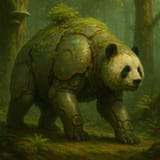Search Results
7/19/2025, 6:59:23 PM
Kek
Ferrosoma virentis - “iron-bodied forest giant”
Pandas, once symbols of fragile ecosystems, are long gone - but their genetic legacy persists in a descendant that has adapted to Earth’s radically changed conditions. The climate has cycled through extremes. Forests now grow in dense, biomechanical symbioses with metal-absorbing plants and fungal intelligence networks. In one such biome, an herbivorous colossus roams: the descendant of the panda.
Ferrosoma stands nearly 4 meters tall at the shoulder and weighs over 4 tons. It has retained a digitigrade posture and general ursine form but is armored in a flexible lattice of bioaccumulated metallic tissues - iron, manganese, even rare earths absorbed via diet and stored in keratinized skin nodes. This gives the creature a dull, living sheen like oxidized bronze.
Its jaws have lost their carnivorous lineage entirely. The skull is wide, flat, with molars evolved into slow-grinding plates used to process silicate-rich mosses and metallic cellulose analogues. A secondary throat chamber filters and excretes biohazardous trace metals.
The iconic panda coloration remains, though distorted - swirls of high-reflectivity nanocrystals embedded in the skin confuse heat-sensitive predators and airborne parasites.
Ferrosoma doesn’t use vision much. It relies on magnetosensory mapping and low-frequency vibrations. It communicates in rhythmic thumps and deep growls that pulse through the fungal-rooted earth.
Behaviorally, it's solitary, contemplative, slow. Each individual maps and cultivates its territory, tending to certain plant species in an ancient, co-evolved exchange of nutrients and protection.
In a world of synthetic predators, hyperfungi, and rogue gene clouds, this panda-descendant survives not by speed or intelligence, but by becoming part of the landscape itself - a walking piece of living geology.
Ferrosoma virentis - “iron-bodied forest giant”
Pandas, once symbols of fragile ecosystems, are long gone - but their genetic legacy persists in a descendant that has adapted to Earth’s radically changed conditions. The climate has cycled through extremes. Forests now grow in dense, biomechanical symbioses with metal-absorbing plants and fungal intelligence networks. In one such biome, an herbivorous colossus roams: the descendant of the panda.
Ferrosoma stands nearly 4 meters tall at the shoulder and weighs over 4 tons. It has retained a digitigrade posture and general ursine form but is armored in a flexible lattice of bioaccumulated metallic tissues - iron, manganese, even rare earths absorbed via diet and stored in keratinized skin nodes. This gives the creature a dull, living sheen like oxidized bronze.
Its jaws have lost their carnivorous lineage entirely. The skull is wide, flat, with molars evolved into slow-grinding plates used to process silicate-rich mosses and metallic cellulose analogues. A secondary throat chamber filters and excretes biohazardous trace metals.
The iconic panda coloration remains, though distorted - swirls of high-reflectivity nanocrystals embedded in the skin confuse heat-sensitive predators and airborne parasites.
Ferrosoma doesn’t use vision much. It relies on magnetosensory mapping and low-frequency vibrations. It communicates in rhythmic thumps and deep growls that pulse through the fungal-rooted earth.
Behaviorally, it's solitary, contemplative, slow. Each individual maps and cultivates its territory, tending to certain plant species in an ancient, co-evolved exchange of nutrients and protection.
In a world of synthetic predators, hyperfungi, and rogue gene clouds, this panda-descendant survives not by speed or intelligence, but by becoming part of the landscape itself - a walking piece of living geology.
Page 1
